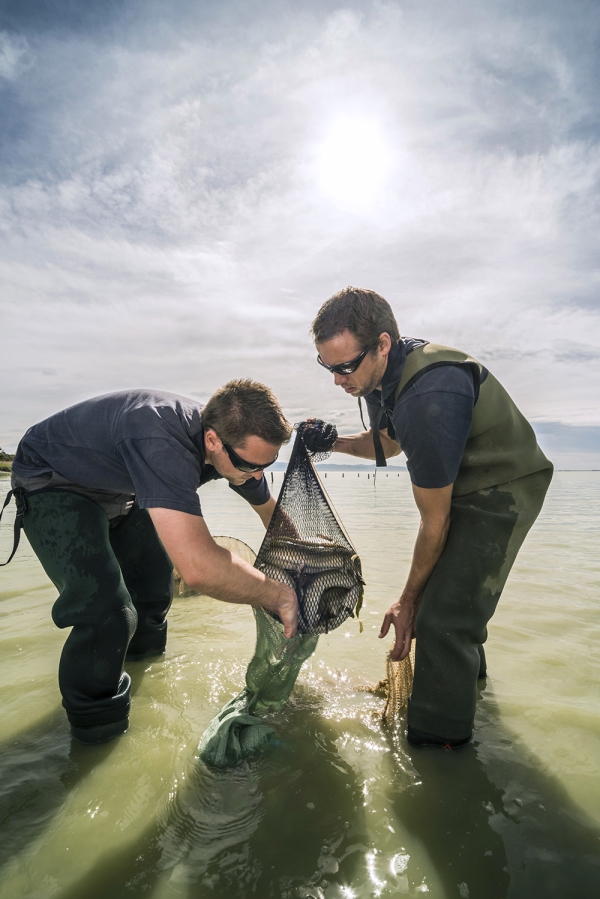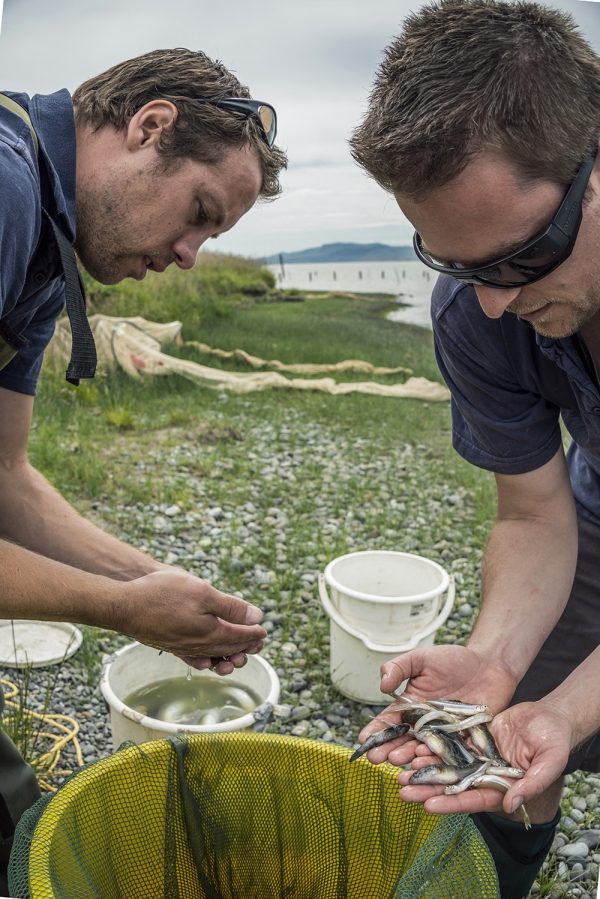Te Waihora is a special lake in need of some intensive care. Together, scientists, iwi, locals and environmentalists are pooling their knowledge and resources to make it better.
A few drops of clove oil in a bucket full of eels is all it takes to stop them wriggling long enough to do their bit for science.
It’s a natural anaesthetic and today NIWA scientist Phil Jellyman is doing the honours. He and colleague Shannan Crow have hauled in four nets from the shallows of Te Waihora, an hour out of Christchurch, and spend the next hour counting and sorting their catch. They throw back the smelt and the bullies, then measure the eels and flounder while Birmingham University student Lani Dines records the details. And, just as the effect of the clove oil wears off, they release the fish back into the lake again.
Dr. Shannan Crow (left) and Dr. Phil Jellyman (right) collecting catches of longfin and shortfin eels in Te Waihora (Lake Ellesmere).
The sun makes the water dance in the early morning. It is sparklingly still, something Crow and Jellyman insist almost never happens. Working conditions here, they say, are generally cold, rainy and the lake choppy and inhospitable.
It may look idyllic, but all is not well at Te Waihora. The lake is a milky glacial green – less than a metre offshore the bottom is invisible.
Dr. Phil Jellyman (left) and Dr. Shannan Crow (right) holding a by-catch of bullies and smelt with catches of longfin, shortfin eels and Te Waihora (Lake Ellesmere) in the background.
This place is a taonga for Ngāi Tahu, originally named Te Kete Ika o Rākaihautū, the Fish Basket of Rākaihautū. Fish have been extensively traded since before European settlement and today, in addition to customary fishing there are three main commercial fisheries for eels, flounder and yellow-eyed mullet.
But Te Waihora/Lake Ellesmere, New Zealand’s fifth largest lake, is also one of its most polluted. It started noticeably deteriorating in the 1960s when massive beds of plants growing in the lake, known as macrophytes, began to decline and then disappeared. That decline was exacerbated by the Wahine storm of 1968 that literally tore them out of the lake.
Macrophytes are multi-taskers. They buffer waves, improve water quality and provide diverse habitats for fish. Without them, there is more sediment erosion, turbidity and changes to the distribution of fish. Now work is under way to re-establish them and to regenerate the lake. In 2011 Ngāi Tahu signed an agreement with Environment Canterbury called Whakaora Te Waihora, to turn the tide. Together they share a commitment to restoring the lake’s health and NIWA is at the forefront of making it happen.
The eel project is one small part of the restoration. Over time they will be caught and re-caught and their measurements documented and compared as one indicator of how the lake is faring.
And in January a 100m-long wave barrier is being installed on the south eastern side of Timber Yard Point. The barrier uses 59 New Zealand Oregon logs, each 10m long. They will be arranged three deep side-by-side, with the remainder placed in a triangular pattern to brace the barrier which will then be anchored to the lake bed in several places. A cable will run the length of the barrier to hold it together.
The purpose of the barrier is to enable the young transplanted macrophytes to become established so that they can do their bit to help prevent erosion and improve water quality.
It’s the first time a barrier like this has been installed in New Zealand and has been purpose-built by NIWA staff. Warren Thompson has been overseeing its construction and will be lakeside when the complicated process of transporting and installing it takes place.
“We need to get the logs in without damaging the shoreline. Once that’s done we’ll tow them into position and hook them up to the anchors. What we really need is for the weather to be perfect.”
Then NIWA freshwater ecologist Mary de Winton can get to work.
She is leading the macrophyte restoration project, thought to be the only one of its type in the world.
“It’s a leap of faith. There are no examples for us to follow and no guarantees either. We’re tapping into local knowledge and we’re taking it one step at a time.”
A macrophyte culture nursery has been established at nearby Taumutu on land leased from the owner, who also looks after the facility. Whānau from Taumutu Marae have offered extensive local knowledge on the lake and its history and shown researchers the best places to look to source seeds and plants and the Halswell River system neighbouring the lake has provided a good supply of macrophyte species. They will be replanted in Te Waihora over the next two years.
“We’ve chosen the sites we think will give them the best chance of survival. If we can get them to re-establish long term, we are confident they will have significant benefits for the future of the lake,” Ms de Winton says.
“Even if the beds fail to re-establish long term, we hope we may better understand why they never recovered naturally and why they struggle to survive in current conditions.”
It is a daunting project and one everyone involved in knows will take considerable time, effort and resources to achieve. But at the heart of the work lies optimism for the future.
Te Waihora has been described as an understated beauty, teeming with life – a wilderness at the edge of a city and “an incredibly valuable resource that really needs looking after”. With the collective knowledge of all those involved it now has the very best chance of recovery.
WHAKAORA TE WAIHORA
The aims of Whakaora Te Waihora are to:
- Accelerate the restoration of an internationally significant wetland noted for wildlife.
- Starting restoration of specific cultural sites and mahinga kai.
- Protect and restore lake margin wetland habitats.
- Improve lake and catchment management practices by focusing on sustainable land use.
- Establish robust monitoring programme.


